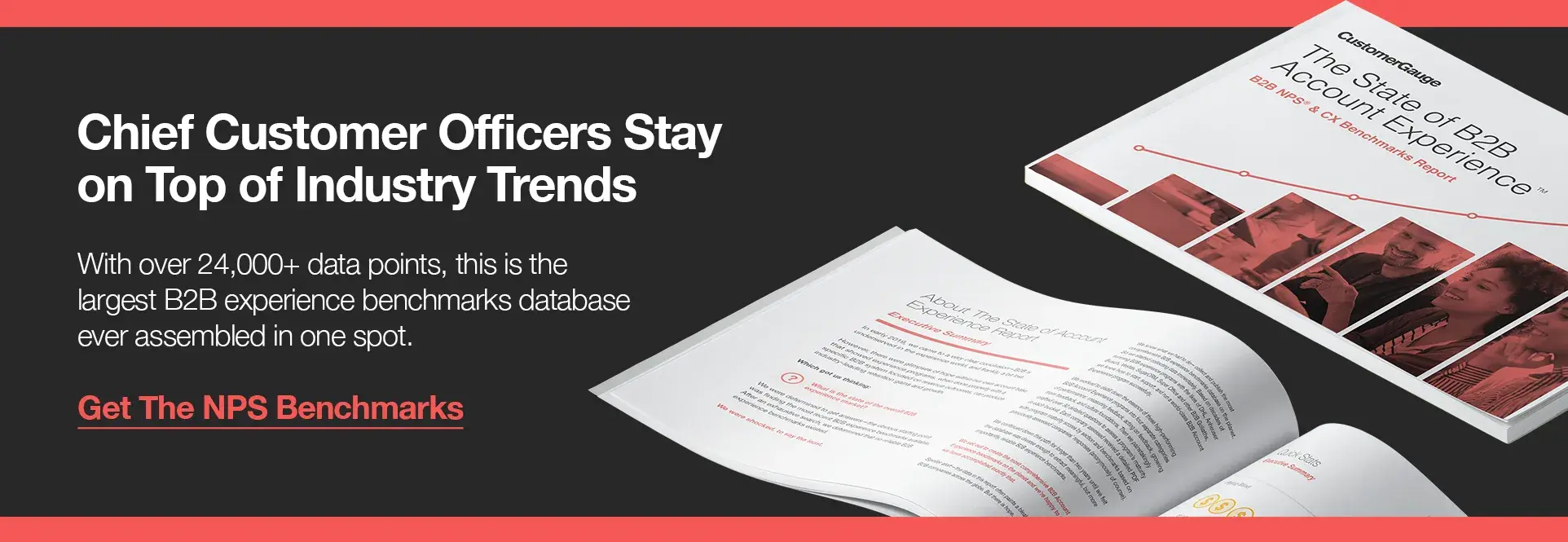Say hello to the newest member of the C-suite: the chief customer officer (CCO).
Nearly 90% of organizations have a CCO or equivalent—and there’s no signal that this trend will slow down soon.
Only recently the long term value of an existing customer was largely an afterthought for businesses. But now it’s become a priority.
According to Gartner’s Customer Experience Survey, 81% of marketers report that they’re competing mostly or entirely on customer experience (CX). And this makes the CCO a crucial figure among any business’s executives.
But what exactly does a CCO do? And what challenges do they face?
In this article, we take a look at everything you need to know about the chief customer officer—including what they can do for you.

Why Hire a Chief Customer Officer?
First, some context. We’ve seen that companies are increasingly turning to CCOs for support. But why?
Over the years, the value of the customer has come to the forefront for businesses:
Customer experience has become the biggest brand differentiator—and is more important than both product and price. In fact, CX drives over two thirds of customer loyalty.
Businesses that commit to their CX efforts grow their revenues up to 8% higher than competitors. Companies that make CX their priority see customer retention and customer lifetime value grow twice as fast as companies that don’t.
Now, organizations are recognizing the power of CX. According to one study, 90% of businesses now see CX as a primary focus.
Committing to your customer experience drives business growth. And that’s largely down to the role of chief customer officer, who drives the visibility and importance of customer experience company-wide.
It’s time to meet your next hire:
What is a Chief Customer Officer?
The chief customer officer is the person that takes full responsibility for all things related to the customer.
The responsibility for a customer-centric culture and revenue growth opportunities with existing customers was once spread across multiple executives. But now, the CCO—or someone in an equivalent role, like the chief experience officer (CXO), or chief client officer—takes full ownership of these realms through leveraged physical and digital communication channels.
Ultimately, the chief customer officer digs deep into what makes a customer tick. They see fully the entire lifecycle of the customer. And they recognize what metrics actually matter to understand these components.
So, what does that mean in practical terms? Here are some of the key tasks of the CCO role:
Chief Customer Officer Job Description: Key Responsibilities
Be the driving force behind building a customer-centric culture—at all levels of the organization. The CCO is a customer advocate. That means they’ll be the voice defending the perspective of the customer at all times.
Build a 360-degree view of the customer. The CCO will be the person driving a deeper understanding of customer needs, satisfaction, and their overall experience.
Identify gaps or weaknesses in CX across all touchpoints in the customer journey. Whether that’s in customer service or sales, the CCO will be the first to assess how customer satisfaction can be improved.
Develop a customer strategy that delivers revenue growth. 70% of firms aren’t connecting their CX efforts to their bottom line, according to CustomerGauge research. But a successful CCO will need a compelling customer experience management (CXM) strategy to drive growth—by boosting customer retention, cutting churn, and encouraging referrals from profitable customers.
Support frontline teams in optimal CX delivery. Whether that’s providing information, securing technological support, or improving employee experience, the CCO will need to know how to help employees to deliver the best customer support possible.
Prove CX results to the highest levels of the company. 62% of businesses don’t know how to calculate the ROI of their CX efforts. This is a problem. It’s your CCO’s role to prove your CX is having an impact.
Improve product development by listening to customers. Customer experience isn’t just about marketing or sales. Rather, it’s part of the CCO’s job to enable development teams to optimize their products based on customer feedback.
What Is the Salary of a CCO?
According to data from Glassdoor and Salary.com, chief customer officers can expect to earn about $200,000 a year. In the US specifically, the average base salary for a CCO is between $195,000 and $275,000.
Where Does the Chief Customer Officer Fit in the Organizational Structure?
Where the CCO position sits in the structure of your organization will depend on how you’re organized already.
In some businesses, the CCO may report to the chief marketing officer (CMO), as marketers are most often seen as CX leaders within an organization.
But it’s increasingly common for CX to become its own function in businesses too. As such, CCOs are increasingly reporting directly to the chief executive officer (CEO) themselves. In fact, according to a study by Gartner, over two thirds of CCOs and CXOs now report to CEOs or chief operating officers (COOs).
What’s the ROI of a Chief Customer Officer?
Now you know what sort of role your CCO will fulfill. But where does the chief customer officer actually add value to the business?
We need to talk about the ROI of your CCO. While the answer is more complex than meets the eye, there are two places to start looking.
- Firstly, a customer-centric culture. While difficult to measure, your company’s culture is one of the most significant returns on your investment in a CCO. Why? It has impacts for:
Your product development. By understanding feedback from the customer base, development teams can make more efficient improvements, rather than just guessing what the customer wants.
Marketing. By pushing customer success stories publicly, the customer feels cared for. This can convince future prospects that your business cares deeply about their clients’ success.
The whole organization. By putting customer and employee experience front and center, CCOs will help the whole organization flourish. According to the Harvard Business Review, companies that invest in employee experience can be as much as four times more profitable than those that don’t.
Indeed, while improving company culture is great, the real ROI of your CCO comes from revenue growth. This means:
Customer retention. Sustainable recurring revenue from existing customers. If this is improving, your CCO is doing the right thing. A CCO should own retention and make continuous moves to understand the drivers of customer churn and prioritize which ones to fix first.
Internal growth. Tapping into the current customer base to grow businesses through up-sells, cross-sells and referral marketing. Customer lifetime value—namely the average amount of value you can expect to make from each customer—will be a critical metric to measure your CCO’s success.
Customer satisfaction. Metrics such as the monetized Net Promoter Score can tell the executive level whether the CCO is driving customer happiness, loyalty, and retention.
Generating customer referrals. A CCO should run your Net Promoter program and leverage customer feedback at-scale to drive new referrals. Activating your referral engine in the B2B space is a powerful growth lever.

What are the Challenges of a CCO?
Finally, incorporating any new function into your c-suite can pose some difficulties—both for your company and the CCO themselves. Here are some of the key elements that you can expect to be a challenge:
Getting buy-in from across the organization. When it comes to encouraging and delivering customer success, CCOs need to be given the power to get everyone on board. Resistance to change is common, particularly when it has the power to threaten departmental control. But solid leadership can make a difference.
Setting clear goals that are tangible for everyone. CustomerGauge research found that companies that set CX goals grow twice as fast as those that don’t. But only 20% of companies are sure their entire organization knows how CX affects their strategy. Setting clear, achievable, and compelling goals can help.
Cutting through misconceptions. According to a study by Bain, 80% of companies believe they provide a “superior experience” to their customers. However, only 8% of customers agreed. It’s the role of a chief customer officer to tie the business’s perceptions to real data.
Neglecting employee experience. To ensure you get real change from your CX program, you can’t afford to neglect your staff. If employees aren’t having a positive experience, it’s unlikely they’ll have the ability or will to deliver a customer-centric approach. It’s the role of the chief customer officer to change that.
Securing investment for technical support. CCOs can only do so much without the right tools—for measuring customer sentiment, data analytics, and closing the loop. Making the case for the value of customer experience management software means being clear about its ROI.
Become a Customer-Focused Company with CustomerGauge
The role of the chief customer officer has gone mainstream. Now’s the time for your business to secure the right investment in customer experience.
At CustomerGauge, we can help. Our CXM platform ties concrete customer data to your bottom line, so you can see the impact your CCO is having on revenue growth in real time.

